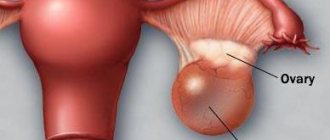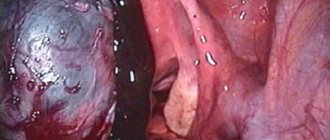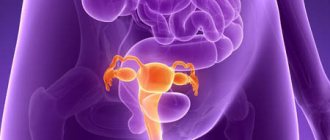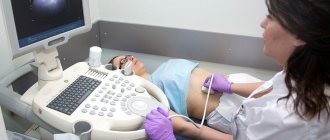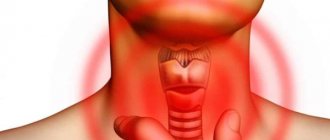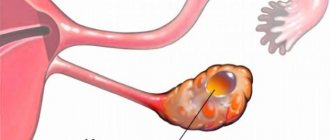Ovarian cysts form most often in women of reproductive age, but the development of a tumor can occur after menopause, which is a serious stress for the body. Ovarian cysts in women after 50 years of age often develop of an organic type. Specialists at the Yusupov Hospital, when treating patients with signs of an ovarian cyst, determine its type and observe the dynamics of development and, based on the data obtained, draw up a treatment program.
Risk group
Certain categories of women are more susceptible to this pathology. This is determined both by external reasons and by their lifestyle. Factors that increase the risk of developing ovarian cysts after age 50:
- early menopause;
- diseases of the appendages;
- absence of pregnancy, childbirth, full breastfeeding;
- past or current infectious diseases of the genital organs;
- a large number of abortions, miscarriages;
- predisposition to the occurrence of uterine fibroids;
- the course of inflammatory processes in the genital area or their presence in the anamnesis;
- involutive changes in the ovaries before menopause;
- uterine bleeding;
- taking oral contraceptives and other hormonal drugs in the past.
With an ovarian cyst that arose before menopause, changes often occur during its onset - it can accelerate growth or, conversely, stop increasing in size.
These factors do not always contribute to the occurrence of pathology. They increase the risk of any gynecological diseases, but their presence does not indicate the exact development of cysts.
Possible consequences and complications
Consequences develop in the absence of medical intervention or in the wrong selection of treatment. An independent attempt to eliminate the disease with the help of folk and other ineffective means can accelerate the growth of education or not have the desired effect, which can also have a negative impact on health.
The likelihood of complications is high during the course of a malignant process in the appendage; detection of cancer in the last stages is especially dangerous.
Possible consequences of ovarian cysts after 50 years:
- disruption of the functioning of neighboring organs due to their compression;
- development of oncology;
- the need for complete removal of the genitals;
- rupture of the cyst or the ovary itself.
Any types of formations at this age require immediate treatment.
Ovarian cysts in women over 50 years of age are most often eliminated by taking medications or undergoing surgery. The latter method is considered the most effective and prevents many of the consequences of pathology. To prevent the development of the disease, it is necessary to visit a gynecologist every six months - this is especially important at the onset of menopause.
Types of formations characteristic of menopause
There are two main types of ovarian cysts in women - functional and epithelial. The former develop under the influence of menstrual irregularities and often go away on their own. After the onset of menopause, there are no periods, therefore, the risk of such a disease is minimal.
Functional cysts are present in a woman’s body after 50 years only if the menstrual cycle continues.
Epithelial formations can appear at any time.
They, unlike other types of pathology, are considered the most dangerous - they are the ones who have a tendency to degenerate into malignant tumors. Their occurrence at any age requires immediate treatment. Types of ovarian cysts during menopause, present in the right or left appendage:
- Papillary. It has many papillae and is prone to active enlargement, including growth into the walls of neighboring organs.
- Endometrioid. Consequence of a long course of endometriosis. Contains brown liquid mixed with blood.
- Mucinous. Capable of growing quickly. It is a combination of several mucus-filled capsules.
- Serous. A single formation with liquid inside, has a round shape.
- Paraovarian. The internal contents are liquid. Often grows to large sizes.
- Dermoid. It usually occurs in the womb, but can grow throughout life. Contains tissues of hair, nails, skin, etc. It is a consequence of intrauterine development disorder.
Clinical features of ovarian cysts in menopause
A distinctive feature of hormonally active functional formations - follicular and luteal cysts - is a change in the menstrual cycle. With pathology of the left or right ovary, there is a delay in menstruation for up to 30 days, after which periods come heavy, painful and prolonged. During menopause, this symptom is not indicative. During the premenopausal period, the menstrual cycle becomes irregular, and long delays do not frighten the woman. Heavy periods are also quite common, even if the discharge was moderate before age 45. All this leads to the woman not paying attention to the signs of a cyst and delaying a visit to the doctor.
Causes of pathology
The reasons that provoke the formation of cysts in women after 50 years of age often act in conjunction with risk factors. It can be difficult to establish them in the absence of serious deviations in the patient’s health.
The main causes of formations:
- hormonal imbalance – often present with the onset of menopause;
- inflammatory process in the genital organs;
- uterine bleeding of varying intensity;
- taking medications without a doctor’s indication;
- early menopause;
- the presence of infections and fungi in the genitals;
- previous gynecological surgical interventions;
- injury to the pelvic area.
Most often, cysts after 50 years are formed under the influence of hormonal changes characteristic of the onset of menopause.
Symptoms of the postoperative period
The symptoms that accompany women during menopause, as well as after removal of the ovary in postmenopause, are divided into three main groups:
- Changes in the psycho-emotional state, accompanied by impaired memory abilities, frequent depression, increased levels of irritability, an unreasonable feeling of fear, sleep disturbance, the appearance of insomnia, chronic fatigue and tearfulness.
- Disturbances of the neurovegetative system, manifested by the appearance of headaches, feelings of dizziness, the formation of hypertensive crises, painful sensations in the heart, the appearance of bouts of heat and increased sweating, and sensations of numbness in the extremities.
- Changes in metabolic processes, including dysfunction of the urogenital organs, rapid gain of extra pounds, disruption of the structure of hair and skin.
Symptoms
At the initial stage of development, formations on the appendages are rarely accompanied by any symptoms. Signs of their presence appear as they grow.
Symptoms of a cyst on the ovaries in a woman over 50 years of age:
- increased urination;
- asymmetry of the abdomen or its enlargement;
- nagging and aching pain in the lower abdomen - the affected ovaries during menopause can hurt more strongly during physical activity and sexual intercourse;
- bleeding from the vagina;
- phlebeurysm;
- constipation
These signs occur when the formation reaches a large size. Some of them are associated with increased pressure from the cyst on neighboring organs - this is manifested by the appearance of varicose veins, disruption of the intestines, etc.
Possible complications
If the cyst is mobile and twists or perforation occurs, complications may develop. When twisted, the woman feels severe pain, her body temperature rises, bleeding appears, and vomiting with nausea.
Rupture of the cyst is accompanied by severe pain and internal bleeding. The consequences of rupture are the appearance of scars and adhesions to nearby organs.
If a tumor is detected promptly during menopause, it rarely becomes malignant. The best prevention of the disease is regular consultations and examinations with your doctor, and a healthy lifestyle.
Diagnostics
To identify the presence of pathology, a large number of examinations are not required. The only difficulty can be caused by determining the type of cyst.
Diagnostic measures to identify formations on the appendages:
- interviewing the patient - determining the symptoms of the disease, how long ago they appeared, the presence of current or past diseases of the genital area;
- gynecological examination - assessment of the condition of the internal female organs, their soreness, determination of deviations in their structure;
- vaginal smear - analysis of local microflora, identification of possible infection, the presence of blood impurities in the discharge;
- Ultrasound - determination of the size of the ovary and the formation itself;
- MRI – study of the structure of the cyst, the degree of its growth;
- biopsy - removal of part of the formation to identify its type;
- laparoscopy is a minimally invasive surgical procedure performed both for diagnosing the genital organs and for subsequent treatment;
- blood tests for tumor markers - identifying the presence of cancer cells in the body.
If a malignant tumor is detected, the patient is additionally prescribed an X-ray of the lungs and an ultrasound of neighboring organs and lymph nodes to determine possible metastasis.
How to diagnose
To detect cystic formations, there are the following diagnostic methods:
- take a pregnancy test - during menopause, the symptoms of a cyst are similar to those of an ectopic pregnancy;
- gynecological examination;
- Ultrasound examination is the most informative method that will help not only confirm or refute, but also indicate the size of the formation;
- laparoscopy;
- CT scan – allows you to find out the nature of the pathology, position, size, which is very important for surgical therapy;
- blood test for hormones and tumor markers;
- puncture of the posterior vaginal wall to determine the presence of fluid or blood in the abdominal cavity.
Treatment methods
The choice of treatment method depends on the size of the cyst and its type, the woman’s age, and her individual characteristics. To eliminate the pathology, medication, surgery, or some traditional types of therapy are used. Often, to achieve optimal results, treatment methods for ovarian cysts during menopause are combined.
Taking medications
This type of therapy is relevant for formations no more than 5-7 cm in diameter that are not prone to rapid growth. Treatment of ovarian cysts after 50 years with medications is prescribed only if one appendage is affected, with a low probability of a malignant process.
Drugs to eliminate pathology:
- hormonal - this therapy is used in premenopause or for hormonal types of ovarian cysts;
- antitumor - inhibit the growth of the tumor, reduce its size;
- improving local blood supply - allowing the ovarian cyst to resolve on its own during menopause;
- immunostimulants – increase the level of immunity;
- anti-inflammatory – prescribed in the presence of inflammatory processes in the genital organs;
- painkillers – make the patient feel better;
- antibacterial - necessary in the presence of genital tract infections.
When treated without surgery, a postmenopausal woman with an ovarian cyst is advised to maintain sexual rest, avoid excessive physical activity, and create a balanced diet. This will help speed up the healing process. If during menopause it is impossible to treat an ovarian cyst with medication or the prescribed medications do not have an effect, surgical intervention is necessary.
Homeopathic remedies
Homeopathic medicines help speed up the elimination of the cyst, restore the functioning of the genital organs, and reduce the symptoms of menopause. They are often used in the presence of thyroid diseases.
Types of homeopathic remedies for the treatment of pathology:
- Bromium;
- Apis;
- Climaxan;
- Berberis;
- Kalium;
- Laurocerase.
Homeopathic medicines with hormonal action, such as Klimaxan, can be used for ovarian cysts only with the permission of a doctor.
This therapeutic method is used as an auxiliary method or when it is impossible to use another type of treatment.
Operation
Most types of epithelial formations are removed through surgery. Cases of cure of malignant ovarian cysts during menopause are most common after surgery. This is justified by the greatest effectiveness of this method of therapy among others, and the low risk of recurrence of the pathology.
Treatment tactics
In fact, an ovarian cyst in menopause is, at a minimum, a precancerous condition, and at a maximum, a malignant tumor in the uterine appendages. An obligatory element of treatment tactics is tumor removal: during surgery, a rapid biopsy is always performed. If the laboratory answers that it is a borderline tumor or ovarian cancer, then the doctor will perform radical surgery. Further treatment tactics depend on the final histological diagnosis.
In women in menopause, cystic neoplasms in the area of the uterine appendages (especially with sudden bleeding during menopause) are a high risk of cancer, therefore an ovarian cyst in postmenopause is an indication for surgical removal of the tumor.
Sources:
https://kistaoff.ru/yaichniki/kista-v-menopauze https://tvoiyaichniki.ru/kista/vidy/posle-50-let https://zen.yandex.ru/media/id/5b6d6f868f29f600a9848967/5d5266150ce57b00c1d826c1

